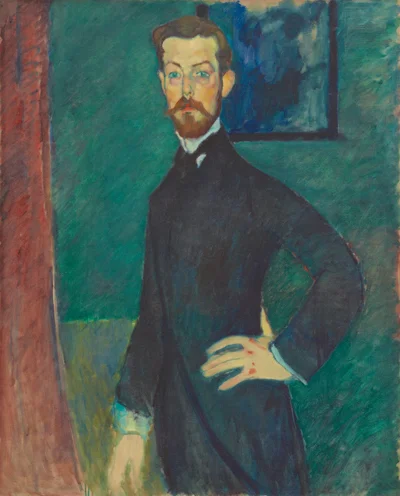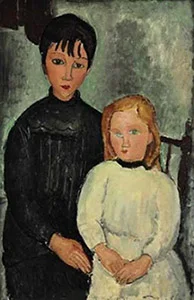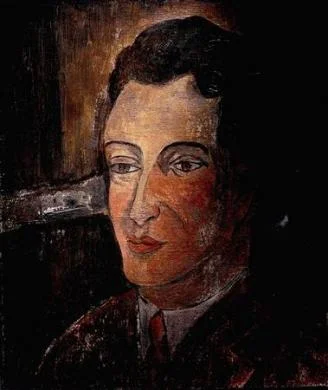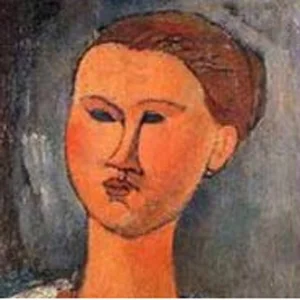Modigliani Chronology
Date
Event
1884
July 12, Modigliani was born to Flaminio and Eugenia Modigliani in Livorno, Italy.
1884-94
Modigliani was home-schooled by his mother. He was also introduced to the radical literature of Nietzsche by his grandfather, Isaco Garsin.
1895
Modigliani suffered from pleurisy.
1897
Modigliani’s mother allowed him to study drawing.
1898
Modigliani developed typhoid fever at the age of 14.
1898-00
Received artistic instruction from Livorno artist, Guglielmo Micheli. Studied landscapes, portraiture, still life, and nudes.
1900
At the age of 16 contracted tuberculosis and suffered from a second bout of pleurisy.
1900-01
Traveled with his mother to southern Italy, visiting the Palazzo Piti and the Uffizi, and staying in Naples, Rome, Amalfi, and Capri. Wrote extensively to his friend in Livorno, Oscar Ghiglia. Upon returning to Livorno after traveling in southern Italy, started neglecting his studies to paint and began visiting the local quarry to sculpt in stone.
1901-14
Carved a series of large stone heads.

Head, 1911-13
1902
Studied under Giovanni Fatori at the Scuola Libera di Nudo in Livorno.
1903
Modigliani moved to Venice and was introduced to Art Nouveau and Impressionism at the Biennale.
1903-06
Modigliani studied at the Istituto di Belle Arti and joined the Venice School of Nude Studies. Modigliani began smoking hashish.
1906
Modigliani traveled to Paris where he lived at Le Bateau-Lavoir in Montmartre and rented a studio in Rue Caulaincourt. Modigliani sketched at least a hundred drawings a day that he either destroyed, gave away, or left behind when he moved.
1907
Showed 7 watercolors and oils in the Salon d Automne. Modigliani began showing signs of alcoholism and drug addiction. He destroyed much of his earlier works for being too bourgeois. Modigliani became Dr. Paul Alexandre’s patient. Dr. Alexandre, in turn, became Modigliani’s promoter and patron and allowed Modigliani to live at Rue du Delta art colony in exchange for paintings.
1908
Showed 6 works at the Salon des Independants. Frustration from this show turned Modigliani back to carving stone, a passion reignited by his friend, Constantin Brancusi.
1909
Modigliani went back to Livorno to rest.

Portrait of Paul Alexander, Tokyo Fuji Art Museum, Tokyo, Japan, 1909
1909-13
Modigliani returned to Paris and painted 3 oil portraits of patron Paul Alexandre.
1910
Modigliani met his first serious love, Anna Akhamatova. Their relationship lasted a year. Modigliani’s portraits began to take on the features of his stonework.

Portrait of Anna Ahkatomova, courtesy of RuriC, Switzerland, 1911
1911
Modigliani exhibited his sculptures in the studio of Souza Cardoso.

Head. c. 1911. Limestone. Perls Galleries. New York, NY, USA. 1911
1912
Exhibited a series of sculpted heads, Tetes, ensemble decoratif, in the Salon d’Automne. He went back to Livorno for the last time to work in the quarries of Carrara.
1913
Modigliani’s sculptures and paintings started to have more arabesque.
1914
WWI broke out. Modigliani tried to enlist, but was turned down because of his health.
1914-16
Met English poet, Beatrice Hastings, and lived with her for two years.
1915
Modigliani painted a series of 14 portraits of Beatrice Hastings and a portrait of Juan Gris.

Portrait of Juan Gris, 1915, courtesy of Metropolitan Museum of Art, NY
1916
Met art dealer Leo Zborowski and his wife Anna. Zborowski gave Modigliani a studio and hired his models. Russian sculptor, Chana Orloff, introduced Modigliani to Jeanne Hebuterne, the love of his life. They soon moved in together.

Portrait of Madame Pompadour (Beatrice Hastings), 1915, courtesy of the Art Institute of Chicago, Chicago, IL

Portrait of Leopold Zborowski, 1916
1917
On December 3 Modigliani had his first solo show at Berthe Weill Gallery. The police closed the show within hours because of the nude paintings.

Seated Nude, 1918, Honolulu Academy of Arts
1918
The Germans bombed Paris. Zborowski organized an artistic retreat for Modigliani and a few other artists in Nice. On November 29, Hebuterne gave birth to a baby girl also named Jeanne.

Les Deux Filles, 1918
1918
According to Andrew Johnson of The Independent, UK, a rare work by Modigliani went up for auction for the first time in February, 2009 by Christies. Les Deux Filles, painted by Modigliani in 1918 in the south of France, is one of only 5 double portraits painted by the artist. This painting has been in the collection of a single family for almost a hundred years. Les Deux Filles was bought from Modigliani by the collector Jonas Netter.

Unknown painting by Modigliani found in Serbia, circa 1918, courtesy of a private collection
1918
On September 25, 2007, Ksenija Prodanovic of Reuters in Belgrade reported that an unknown painting by Italian painter, Amedeo Modigliani, would be exhibited in Belgrade in November of that same year. The painting is a “Portrait of a man” dating from circa 1918 and belongs to an anonymous Serbian collector. The president of the Modigliani Institut Archives Legales Paris-Rome, Christian Parisot, said that the painting was authentic. Parisot states that, “It took us 17 years to verify the authenticity and I can now say for certain that it is Modigliani.” The painting exhibits a well-dressed young man with neatly combed hair. Experts said that the oil paints used in the painting had been diluted, a clue that the artist was not wealthy and was trying to make his paints last as long as possible. The identity of the young man was not known, but Parisot “was hoping that somebody would recognize it, once the painting was presented.” City hall officials in Belgrade said the owner of the painting requested that the painting be exhibited for the first time in Belgrade.

Jeanne Hébuterne, 1919, oil on canvas, courtesy the Metropolitan Museum of Art, Gift of Mr. and Mrs. Nate B. Spingold, 1956
1919
In May, Modigliani returned to Paris with Hebuterne and their child. By the summer Hebuterne was pregnant again. They rented an apartment in the Rue de la Grande Chaumiere. Modigliani and Hebuterne painted portraits of each other and of themselves. The Hill Gallery in London showed 10 of Modigliani’s works.

Self-portrait, 1919 Museu de Arte Contemporânea da Universidade de São Paulo, São Paulo, Brasi

Portrait of Modigliani by Hebuterne, 1919, public domain
1920
Modigliani’s health declined, and he died on January 24. Hebuterne committed suicide two days later, at the same time killing her unborn child. The Galeries Montaigne in Paris held the first exhibition of Modigliani’s work after his death.
1922
There was a small retrospective dedicated to Modigliani at the Biennale in Venice.
1923
The Femme au Col Blancwas the first painting by Modigliani acquired by a French Museum, The Musee de Grenoble.

The Femme au Col Blanc, 1917,The Musee de Grenoble, France
1930
The Hebuterne family had their daughter’s body moved to Pere Lachaise Cemetery to lie beside Modigliani.
1958
Modigliani’s daughter, Jeanne Modigliani, published the biography of her father,Modigliani: Man and Myth, in New York.

Portrait of Rosalie Tobia, unknown date, abandoned in staff lavatory in Bergamo airport
2007
On February 28, 2007, Richard Owen, a writer for the UK Times (Timesonline), reported that international art experts were called in to identify a Modigliani painting that had been abandoned in a staff lavatory in Bergamo airport. The painting was found wrapped in a sheet inside a packing box. “It was ready to be slipped through airport controls on to a plane,” a police spokesman said. The painting is a portrait of a woman believed to be Rosalie Tobia who worked as an artist’s model in Paris. Modigliani had painted her several times. Experts say that if the painting is genuine, it would be worth at least €1 million (£670,000). The painting was being held by the Carabinieri art theft squad in Monza.